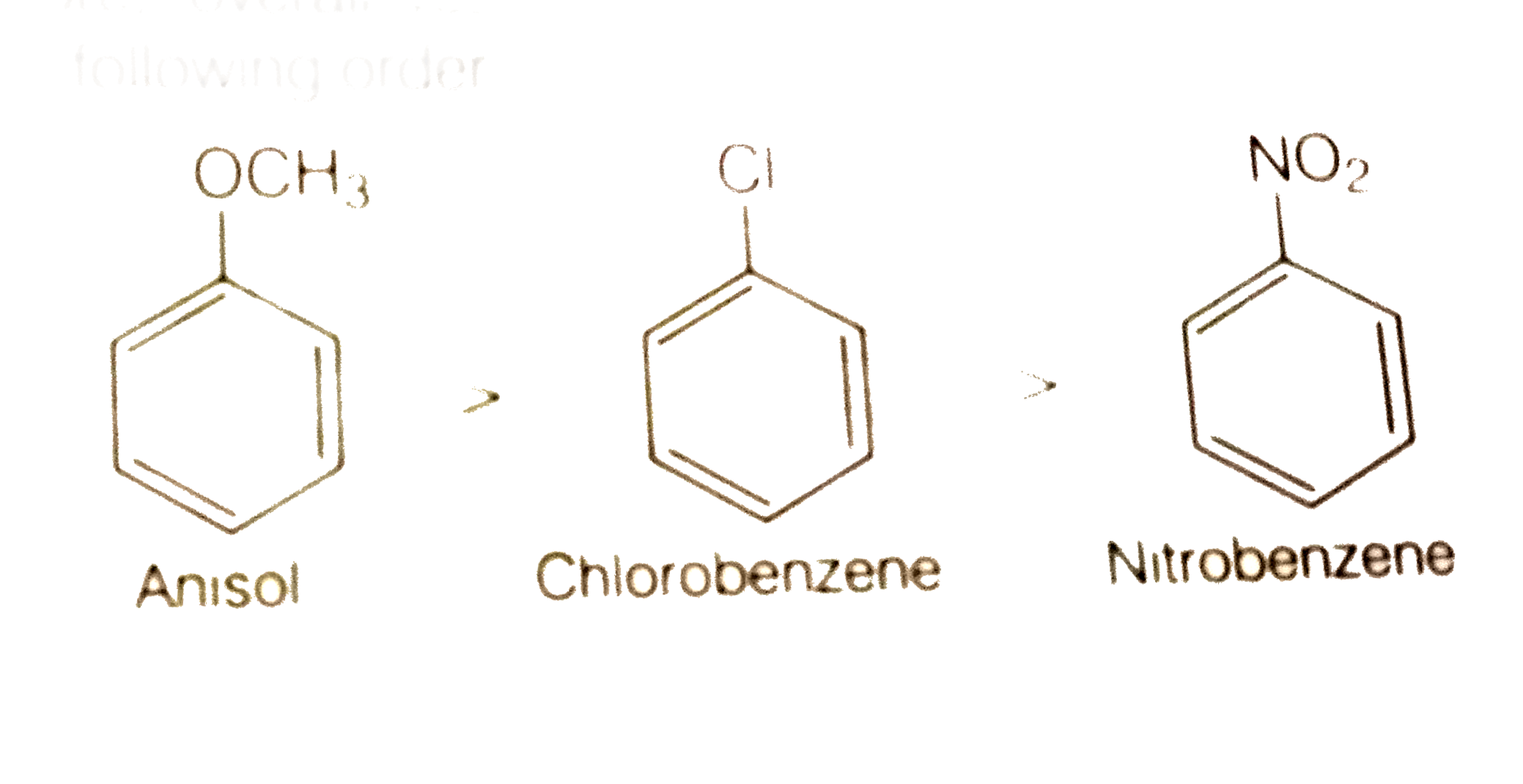Arrange the following set of compounds in the order of their decreasing relative reactivity with an electrophile . Give reason.

The methoxy group(−OCH3) is electon releasing group. It increases the electron density in benzene nucleus due to resonance effect (+R-effect). It makes anisole more reactive than benzene towards electrophile.

In case of alkyl halides , halogens are moderately deactivating because of their strong -I effect. Thus, overall electron density on benzene ring decreases. It makes further substitution difficult.
−NO2 group is electron withdrawing group. It decreases the electron density in benzene nucleus due to its strong - R- effect and strong -I-effect. Hence, it makes nitrobenzene less reactive. Therefore , overall rearll reactivity of these three compounds towards electrophiles decreases in the following order

Topper's Solved these Questions
- HYDROCARBONSBook:NCERT EXEMPLARChapter:HYDROCARBONSExercise:Matching The Columns
Explore 4 Videos
- HYDROCARBONSBook:NCERT EXEMPLARChapter:HYDROCARBONSExercise:Assertion and Reason
Explore 4 Videos
- HYDROCARBONSBook:NCERT EXEMPLARChapter:HYDROCARBONSExercise:Multiple Choice Questions (More Than One Options)
Explore 9 Videos
- ENVIRONMENTAL CHEMISTRYBook:NCERT EXEMPLARChapter:ENVIRONMENTAL CHEMISTRYExercise:Long Answer Type
Explore 5 Videos
- HYDROGENBook:NCERT EXEMPLARChapter:HYDROGENExercise:LONG ANSWER TYPE QUESTIONS
Explore 8 Videos
Similar Questions
Arrange the following set of compounds in order of their decreasing relative reactivity with an electrophile, E+
(a) Chlorobenzene, 2,4-dinitrochlorobenzene, p-nitrochlorobenzene
(b) Toluene, p−H3C–C6H4–NO2,p−O2N–C6H4–NO2.
View SolutionArrange the following set of compounds in order of their decreasing relative reactivity with an electrophile, E+
(a) Chlorobenzene, 2,4-dinitrochlorobenzene, p-nitrochlorobenzene
(b) Toluene, p−H3C–C6H4–NO2,p−O2N–C6H4–NO2.
View Solution
Knowledge Check
Arrange the following set of compounds in the order of their decreasing relative reactivity with an electrophileE+
I.Chlorobenzene
II.2,4 dinitrochlorobenzene
III.P-nitrochlorobenzene
IV.toluene V.p−H3C−C6H4−NO2AI>II>III>IV>VBIV>V>I>III>IICV>IV>III>II>IDI>III>II>V>IVArrange the following set of compounds in order of their decreasing relative reactivity with an electrophile, E+
(a) Chlorobenzene, 2,4-dinitrochlorobenzene, p-nitrochlorobenzene
(b) Toluene, p−H3C–C6H4–NO2,p−O2N–C6H4–NO2.A(iii)>(ii)>(i)B(ii)>(iii)>(i)C(i)>(iii)>(ii)D(i)>(ii)>(iii)Arrange the following compounds in decreasing order of their acidic strength.
 AIV<II<I<IIIBI<II<III<IVCIV<II<III<IDI<III<II<IV
AIV<II<I<IIIBI<II<III<IVCIV<II<III<IDI<III<II<IV
Arrange the following compounds in order of their decreasing reactivity with an electrophile,E(+)
i) Chlorobenzene
ii) 2,4- dinitrochlorobenzene
iii)p- nitrochlorobenzene
View SolutionArrange the following compounds in decreasing order of their basicity?
 .
.
View SolutionArrange the following compounds in order of their decreasing reactivity with an electrophile,E(+)
i) Chlorobenzene
ii) 2,4- dinitrochlorobenzene
iii)p- nitrochlorobenzene
View SolutionArrange the following compounds in order of decreasing reactivity towards SN1 reaction

View SolutionArrange the following compounds in order of decreasing acidic strength.

View Solution

